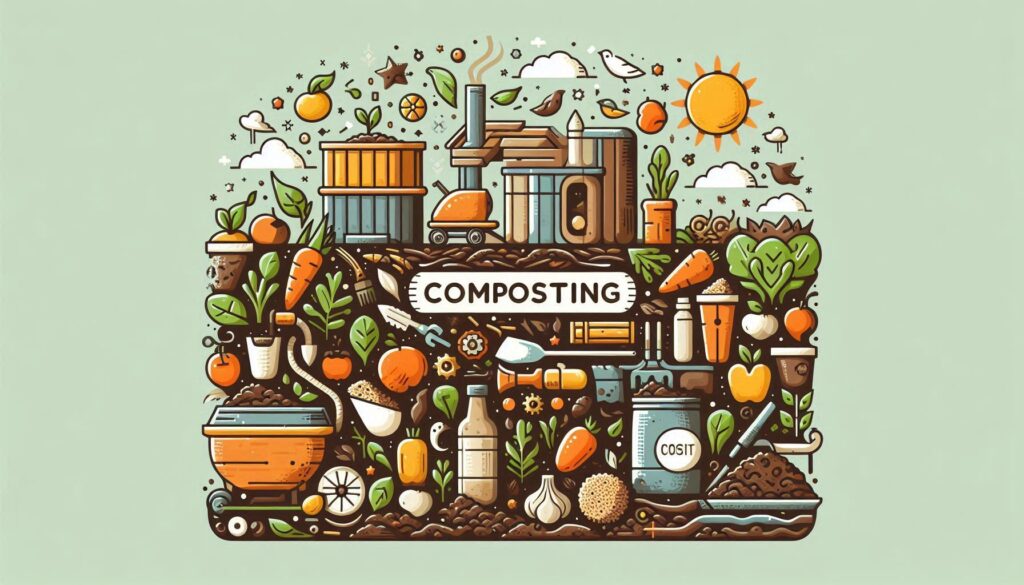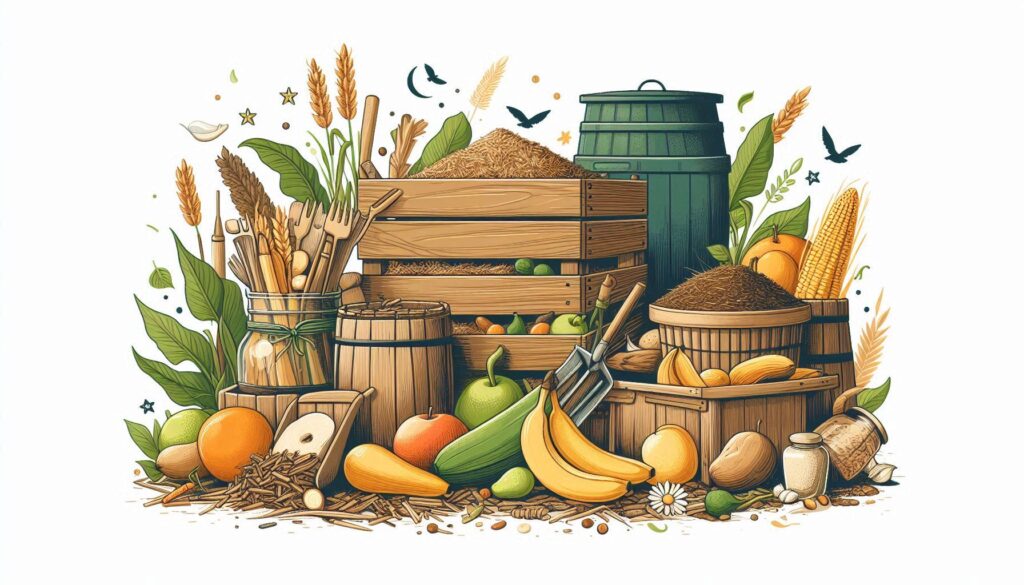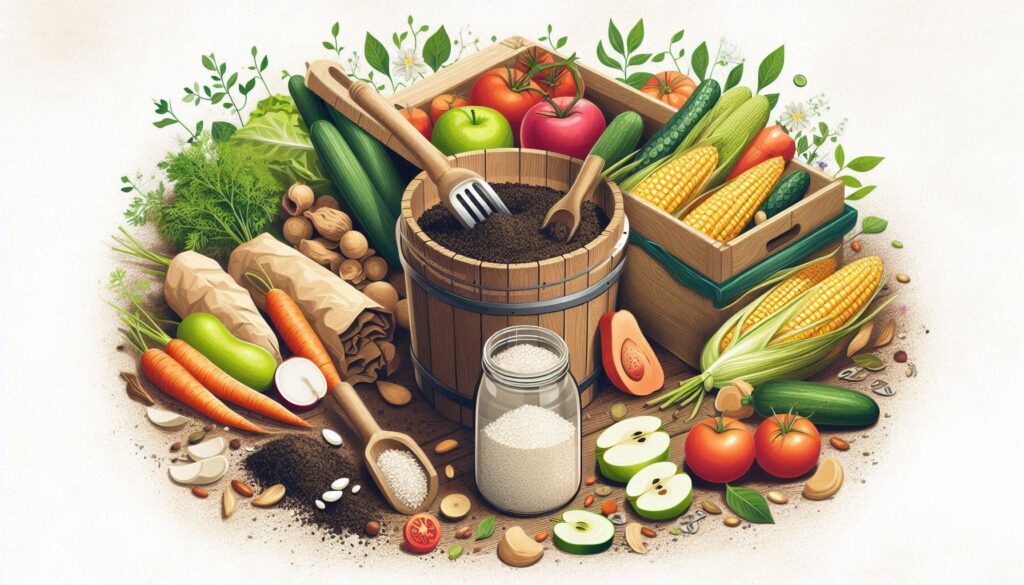Composting is one of the most effective and sustainable ways to improve soil health and reduce waste. Whether you’re a farmer, gardener, or just someone interested in sustainable living, composting offers a simple and rewarding solution to enrich soil naturally. This guide will walk you through the basics of composting, helping you start and manage your compost effectively in organic farming.

What Is Composting?
Composting is decomposing organic materials, such as food scraps and yard waste, into nutrient-rich humus. This humus can be used to enhance soil fertility, structure, and microbial activity. Composting not only recycles organic waste but also helps reduce landfill contributions and carbon emissions.
Why Composting Matters
1. Improves Soil Health
Compost enriches soil with essential nutrients like nitrogen, phosphorus, and potassium. It also improves soil structure, promoting better water retention and aeration.
2. Reduces Waste
Composting diverts organic waste from landfills, reducing methane emissions and the environmental impact of waste disposal.
3. Supports Sustainable Farming
For farmers, composting offers a cost-effective and eco-friendly alternative to chemical fertilizers, enhancing long-term soil productivity and organic farming.
Getting Started with Composting
Step 1: Choose a Composting Method
There are several methods of composting, and the choice depends on your space, time, and goals:
- Backyard Composting: Ideal for small-scale composting using kitchen scraps and yard waste.
- Vermicomposting: Involves using worms to break down organic matter, suitable for indoor or small spaces.
- Commercial Composting: Larger operations for farms and communities.
Step 2: Select a Composting Bin or Pile
- Compost Bin: Enclosed bins are tidy and protect the compost from pests.
- Open Pile: Simple and effective for larger quantities but may require more management.
- Tumbler: A rotating bin that speeds up the composting process.
Step 3: Understand the Ingredients
Composting requires a balanced mix of “greens” and “browns”:
- Greens: Nitrogen-rich materials like fruit scraps, vegetable peels, coffee grounds, and grass clippings.
- Browns: Carbon-rich materials like dry leaves, straw, cardboard, and paper.
Aim for a ratio of 2-3 parts browns to 1 part greens to create a balanced compost pile.
Building Your Compost Pile

1. Start with a Base Layer
Lay down coarse browns, such as twigs or straw, to allow for airflow and drainage at the bottom of your pile.
2. Add Layers
Alternate layers of greens and browns. This layering promotes a balance of nutrients and ensures efficient decomposition.
3. Maintain Moisture
The compost should be as moist as a wrung-out sponge. Add water if it’s too dry, or mix in dry materials if it’s too wet.
4. Aerate the Pile
Turn the compost regularly to introduce oxygen, which speeds up the decomposition process and prevents odors.
What to Compost and What to Avoid
Compostable Materials
- Fruit and vegetable scraps
- Coffee grounds and tea bags
- Eggshells
- Yard waste (leaves, grass clippings, small branches)
- Paper and cardboard (shredded)
Non-Compostable Materials
- Meat, fish, and dairy products (attract pests and cause odors)
- Oils and fats
- Diseased plants
- Pet waste
- Synthetic materials (plastics, metals, treated wood)
Managing Your Compost
1. Temperature
Compost should ideally reach a temperature of 135°F to 160°F to kill pathogens and weed seeds. Use a compost thermometer to monitor the temperature of organic farming.
2. Turning
Turn the pile every 1-2 weeks to maintain airflow and ensure even decomposition. A well-turned pile breaks down faster and produces higher-quality compost.
3. Monitoring
Keep an eye on the moisture level, smell, and progress of decomposition. A healthy compost pile should have an earthy smell and break down into dark, crumbly humus.
Common Composting Problems and Solutions
1. Bad Odors
- Cause: Excessive greens or lack of aeration.
- Solution: Add more browns and turn the pile to improve airflow.
2. Slow Decomposition
- Cause: Imbalanced ratio or insufficient moisture.
- Solution: Adjust the greens-to-brown ratio and ensure the pile is adequately moist.
3. Pests
- Cause: Inclusion of non-compostable items like meat or dairy.
- Solution: Remove problem items and ensure the bin is secure.
Using Finished Compost
1. How to Know It’s Ready
Compost is finished when it is dark, crumbly, and has an earthy smell. It should no longer contain recognizable food scraps or materials.
2. Applications
- Soil Amendment: Mix compost into garden beds to improve soil fertility and structure.
- Mulch: Spread compost around plants to retain moisture and suppress weeds.
- Potting Mix: Combine compost with soil and sand for a nutrient-rich potting mix.
Benefits of Composting for Farms
For farmers, composting is a game-changer. It reduces dependency on chemical fertilizers, improves soil resilience, and supports sustainable agriculture. By closing the nutrient loop, composting helps create a self-sufficient farming system that benefits both the environment and productivity organic farming.

Conclusion
Starting a composting practice is a step toward sustainable farming and living. With the right balance of ingredients, regular maintenance, and a little patience, anyone can turn organic waste into “black gold” for their soil. Composting not only enriches the earth but also empowers you to contribute to a healthier planet.
Are you ready to start composting? Share your questions, experiences, or tips in the comments below!
Here are the top questions to ask people on organic farming, and related topics
- What is composting, and why is it important?
- Composting is the process of breaking down organic materials like food scraps and yard waste into nutrient-rich humus. It’s important because it improves soil health, reduces waste in landfills, and supports sustainable agriculture by recycling nutrients naturally.
- What are the key ingredients for a successful compost pile?
- A balanced compost pile requires a mix of “greens” (nitrogen-rich materials like fruit scraps and grass clippings) and “browns” (carbon-rich materials like dry leaves and cardboard). Maintaining a 2-3 parts browns to 1 part greens ratio is ideal.
- What should you avoid putting in your compost pile?
- Avoid meat, fish, dairy products, oils, diseased plants, pet waste, and synthetic materials. These items can attract pests, cause odors, or disrupt the composting process.
- How can you tell when compost is ready to use?
- Finished compost is dark, crumbly, and has an earthy smell. It should no longer contain recognizable food scraps or materials.
- What are some common composting problems, and how can they be fixed?
- Bad odors: Add more browns and aerate the pile.
- Slow decomposition: Adjust the greens-to-brown ratio and ensure proper moisture.
- Pests: Remove problem items (like meat or dairy) and secure the compost bin.




Your article helped me a lot, is there any more related content? Thanks!
Can you be more specific about the content of your article? After reading it, I still have some doubts. Hope you can help me.
Your article helped me a lot, is there any more related content? Thanks!
Can you be more specific about the content of your article? After reading it, I still have some doubts. Hope you can help me.
Thank you for your sharing. I am worried that I lack creative ideas. It is your article that makes me full of hope. Thank you. But, I have a question, can you help me?